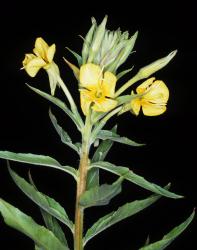- Taxon
- Gallery
Annual or biennial (possibly sometimes short-lived perennial) herb, with stout taproot. Stems to c. 75 cm tall, not or sparingly branched, white-pilose and with short glandular hairs in upper part. Rosette lvs numerous, 0 at flowering, sessile, 3–15 × 0.4–1 cm, narrow-linear to narrow-oblanceolate, glabrous excluding margins; midrib pale; margins undulate, ciliolate, sparsely denticulate, ± undulate. Cauline lvs similar but usually shorter and to 1.6 cm wide towards base, the upper lvs often hairy below. Fls solitary, sessile, crepuscular but lasting well into the next day; subtending lf sheath-like at base and obscuring lower part of ovary, with hairs as on stem. Floral tube 2–3 cm long, narrow-cylindric, with hairs as on stem. Buds narrowly oblong, erect. Sepals 1.7–2.7 cm long, ± reddish, with hairs as on stem; apices mucronate, erect or divergent. Petals 2.5–3.5 cm long, broad-obovate, yellow, ageing to orange-red. Style exserted by 1.5–2 cm. Capsule 2–2.5 cm long, widening slightly in upper 1/2, sometimes curved, ± reddish, slightly ribbed, with long and short hairs. Seeds 1–1.7 mm long, irregular but somewhat ellipsoid, finely reticulate.
[From: Webb et al. (1988) Flora of New Zealand. Volume 4.]
Flowering: Nov.–Jun.




